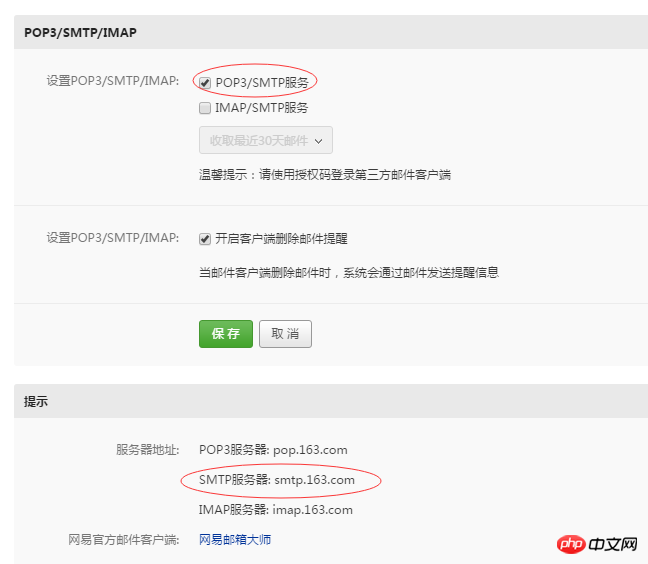Heim >Backend-Entwicklung >Python-Tutorial >Python-Produktionsbeispiel für das Versenden von E-Mails
Python-Produktionsbeispiel für das Versenden von E-Mails
- 巴扎黑Original
- 2017-08-13 14:56:491459Durchsuche
In diesem Artikel wird hauptsächlich die Funktion zum Senden von E-Mails in Python ausführlich vorgestellt. Die verwendeten Module sind smtplib und MIMEText, die einen bestimmten Referenzwert haben.
Die Beispiele in diesem Artikel sind Wir haben den spezifischen Code für Python zur Implementierung der Funktion zum Senden von E-Mails als Referenz freigegeben. Der spezifische Inhalt lautet wie folgt:
Abhängigkeiten:
Der Python-Code implementiert die Funktion Zum Senden von E-Mails wird das Modul smtplib, MIMEText, verwendet. Sie müssen das Paket importieren, bevor Sie den Code implementieren:
import smtplib from email.mime.text import MIMEText
Verwenden Sie 163 E-Mails, um E-Mails zu senden Die Code-Implementierung ist wie folgt:
import smtplib from email.mime.text import MIMEText ''' 发送邮件函数,默认使用163smtp :param mail_host: 邮箱服务器,16邮箱host: smtp.163.com :param port: 端口号,163邮箱的默认端口是 25 :param username: 邮箱账号 xx@163.com :param passwd: 邮箱密码(不是邮箱的登录密码,是邮箱的授权码) :param recv: 邮箱接收人地址,多个账号以逗号隔开 :param title: 邮件标题 :param content: 邮件内容 :return: ''' def send_mail(username, passwd, recv, title, content, mail_host='smtp.163.com', port=25): msg = MIMEText(content) # 邮件内容 msg['Subject'] = title # 邮件主题 msg['From'] = username # 发送者账号 msg['To'] = recv # 接收者账号列表 smtp = smtplib.SMTP(mail_host, port=port) # 连接邮箱,传入邮箱地址,和端口号,smtp的端口号是25 smtp.login(username, passwd) # 登录发送者的邮箱账号,密码 # 参数分别是 发送者,接收者,第三个是把上面的发送邮件的 内容变成字符串 smtp.sendmail(username, recv, msg.as_string()) smtp.quit() # 发送完毕后退出smtp print('email send success.') if __name__ == '__main__': email_user = 'xxxx@163.com' # 发送者账号 email_pwd = 'xxxxx' # 发送者密码,授权码 maillist = 'xxxx@qq.com' title = '测试邮件标题' content = '这里是邮件内容' send_mail(email_user, email_pwd, maillist, title, content)
Die Methode zum Abrufen des Autorisierungscodes für das 163-Postfach ist wie folgt:
1. Melden Sie sich bei 163 an Klicken Sie im Postfach wie folgt auf Einstellungen-POP3/SMTP/IMAP:

2. Aktivieren Sie den SMTP-Dienst und fragen Sie die SMTP-Hostadresse ab:

3. Klicken Sie auf das Client-Autorisierungskennwort, um den Autorisierungscode zurückzusetzen:

Verwenden Sie QQ Mail, um E-Mails zu senden:
import smtplib from email.mime.text import MIMEText ''' 发送邮件函数,默认使用163smtp :param mail_host: 邮箱服务器,qq邮箱host: smtp.qq.com :param port: 端口号,qq邮箱的默认端口是: 456 :param username: 邮箱账号 xx@163.com :param passwd: 邮箱密码(不是邮箱的登录密码,是邮箱的授权码) :param recv: 邮箱接收人地址,多个账号以逗号隔开 :param title: 邮件标题 :param content: 邮件内容 :return: ''' #qq邮箱发送邮件 def send_mail(username, passwd, recv, title, content, mail_host='smtp.qq.com', port=456): msg = MIMEText(content) # 邮件内容 msg['Subject'] = title # 邮件主题 msg['From'] = username # 发送者账号 msg['To'] = recv # 接收者账号列表 smtp = smtplib.SMTP_SSL(mail_host, port=port) # 连接邮箱,传入邮箱地址,和端口号,smtp的端口号是25 smtp.login(username, passwd) # 登录发送者的邮箱账号,密码 # 参数分别是 发送者,接收者,第三个是把上面的发送邮件的 内容变成字符串 smtp.sendmail(username, recv, msg.as_string()) smtp.quit() # 发送完毕后退出smtp print('email send success.') if __name__ == '__main__': email_user = 'xxx@qq.com' # 发送者账号 email_pwd = 'WOSHINIGE123' # 发送者密码,授权码 maillist = 'xxxx@qq.com' title = '测试邮件标题' content = '这里是邮件内容' send_mail(email_user, email_pwd, maillist, title, content)
Mehrere Empfänger mit Anhängen:
# import smtplib # from email.mime.text import MIMEText # ''' # 发送邮件函数,默认使用163smtp # :param mail_host: 邮箱服务器,qq邮箱host: smtp.163.com # :param port: 端口号,qq邮箱的默认端口是: 25 # :param username: 邮箱账号 xx@163.com # :param passwd: 邮箱密码(不是邮箱的登录密码,是邮箱的授权码) # :param recv: 邮箱接收人地址,多个账号以逗号隔开 # :param title: 邮件标题 # :param content: 邮件内容 # :return: # ''' import smtplib from email.mime.text import MIMEText from email.mime.multipart import MIMEMultipart #邮箱服务器地址 email_host = 'smtp.163.com' #发送者 email_user = 'xxxx@163.com' #授权码 email_pwd = 'WOSHINIGE123' #多个收件人,使用分号分隔 maillist ='xxxx@qq.com;aaaa@qq.com' #对多个收件人进行分割,以;为标准,返回结果是list['xxxx@qq.com','aaaa@qq.com'] email_info = maillist.split(';') #构造一个发附件的邮件内容对象 new_msg = MIMEMultipart() #邮件正文内容 new_msg.attach(MIMEText('test email.....')) #邮件主题 new_msg['Subject'] = 'test email' #邮件发送者 new_msg['From'] = email_user #邮件接收者,多个收件人的账号使用,连接,传入类型是str new_msg['To'] = ','.join(email_info) #打开a.txt读取文本内容 att = MIMEText(open('a.txt').read()) att["Content-Type"] = 'application/octet-stream' # 发送附件就得这么写,固定格式,filename指定附件的名字 att["Content-Disposition"] = 'attachment; filename="haha.txt"' new_msg.attach(att) # 连接邮箱,传入邮箱地址,和端口号,smtp的端口号是25 smtp = smtplib.SMTP(email_host, port=25) # 发送者的邮箱账号,密码,先登录 smtp.login(email_user, email_pwd) smtp.sendmail(email_user, email_info, new_msg.as_string()) smtp.quit() print('email send success.')
Verwenden Sie Semikolons zwischen Konten, wenn es mehrere Empfänger gibt; Teilen und ausführen smtp.sendmail (der Typ mehrerer übergebener Empfänger ist list); new_msg['TO'] = recv, der empfangene Typ ist str
Verwenden Sie die Klasse zum Senden von E-Mails, Sie können mehrere Personen senden oder Anhänge senden:
import smtplib from email.mime.text import MIMEText from email.mime.multipart import MIMEMultipart class SendMail(object): def __init__(self, username, passwd, recv, title, content, file=None, email_host='smtp.163.com', port=25): self.username = username self.passwd = passwd self.recv = recv self.title = title self.content = content self.file = file self.email_host = email_host self.port = port def send_mail(self): msg = MIMEMultipart() #发送内容的对象 if self.file:#处理附件的 att = MIMEText(open(self.file, encoding='utf-8').read()) att["Content-Type"] = 'application/octet-stream' att["Content-Disposition"] = 'attachment; filename="%s"'%self.file msg.attach(att) msg.attach(MIMEText(self.content))#邮件正文的内容 msg['Subject'] = self.title # 邮件主题 msg['From'] = self.username # 发送者账号 #将多个账号'aaa.@qq.com;bbbb@163.com' 以分号分割,分割为list self.recv = self.recv.split(';') if isinstance(self.recv, list): msg['To'] = ','.join(self.recv) else: msg['To'] = self.recv # 接收者账号列表 if self.username.endswith('qq.com'): #如果发送者是qq邮箱 self.smtp = smtplib.SMTP_SSL(self.email_host, port=self.port) else: self.smtp = smtplib.SMTP(self.email_host, port=self.port) #发送邮件服务器的对象 self.smtp.login(self.username, self.passwd) try: self.smtp.sendmail(self.username, self.recv, msg.as_string()) except Exception as e: print('出错了。。', e) else: print('发送成功!') self.smtp.quit() if __name__ == '__main__': m = SendMail( username='zzzzz@163.com', passwd='xxxxxxx',file='a.txt', recv='xxxxxx@qq.com;xxxxxx@qq.com', title='多个收件人', content='哈哈哈啊哈哈哈哈', email_host='smtp.163.com', port=25 ) m.send_ma
Das obige ist der detaillierte Inhalt vonPython-Produktionsbeispiel für das Versenden von E-Mails. Für weitere Informationen folgen Sie bitte anderen verwandten Artikeln auf der PHP chinesischen Website!

